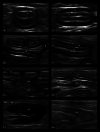Clinical, laboratory and ultrasonographic findings differentiating low-grade intestinal T-cell lymphoma from lymphoplasmacytic enteritis in cats
- PMID: 34687072
- PMCID: PMC8692195
- DOI: 10.1111/jvim.16272
Clinical, laboratory and ultrasonographic findings differentiating low-grade intestinal T-cell lymphoma from lymphoplasmacytic enteritis in cats
Abstract
Background: Low-grade intestinal T-cell lymphoma (LGITL) is the most common intestinal neoplasm in cats. Differentiating LGITL from lymphoplasmacytic enteritis (LPE) is challenging because clinical signs, laboratory results, diagnostic imaging findings, histology, immunohistochemistry, and clonality features may overlap.
Objectives: To evaluate possible discriminatory clinical, laboratory and ultrasonographic features to differentiate LGITL from LPE.
Animals: Twenty-two cats diagnosed with LGITL and 22 cats with LPE based upon histology, immunohistochemistry, and lymphoid clonality.
Methods: Prospective, cohort study. Cats presented with clinical signs consistent with LGITL or LPE were enrolled prospectively. All data contributing to the diagnostic evaluation was recorded.
Results: A 3-variable model (P < .001) consisting of male sex (P = .01), duration of clinical signs (P = .01), and polyphagia (P = .03) and a 2-variable model (P < .001) including a rounded jejunal lymph node (P < .001) and ultrasonographic abdominal effusion (P = .04) were both helpful to differentiate LGITL from LPE.
Conclusions and clinical importance: Most clinical signs and laboratory results are similar between cats diagnosed with LGITL and LPE. However, male sex, a longer duration of clinical signs and polyphagia might help clinicians distinguish LGITL from LPE. On ultrasonography, a rounded jejunal lymph node, and the presence of (albeit small volume) abdominal effusion tended to be more prevalent in cats with LGITL. However, a definitive diagnosis requires comprehensive histopathologic and phenotypic assessment.
Keywords: alimentary lymphoma; cat; chronic enteropathy; full-thickness intestinal biopsies; inflammatory bowel disease; ultrasonography.
© 2021 The Authors. Journal of Veterinary Internal Medicine published by Wiley Periodicals LLC on behalf of American College of Veterinary Internal Medicine.
Conflict of interest statement
Alexander J. German is an employee of the University of Liverpool, but his post is financially supported by Royal Canin, which is owned by Mars Petcare. Alexander J. German has also received financial remuneration for providing educational material, speaking at conferences, and consultancy work for Mars Petcare; all such remuneration has been for projects unrelated to the work reported in this manuscript. No other authors have a conflict of interest.
Figures

References
-
- Rissetto K, Villamil JA, Selting KA, Tyler J, Henry CJ. Recent trends in feline intestinal neoplasia: an epidemiologic study of 1,129 cases in the veterinary medical database from 1964 to 2004. J Am Anim Hosp Assoc. 2011;47:28‐36. - PubMed
-
- Ettinger SN. Principles of treatment for feline lymphoma. Clin Tech Small Anim Pract. 2003;18:98‐102. - PubMed
-
- Gabor LJ, Malik R, Canfield PJ. Clinical and anatomical features of lymphosarcoma in 118 cats. Aust Vet J. 1998;76:725‐732. - PubMed
MeSH terms
LinkOut - more resources
Full Text Sources
Miscellaneous

